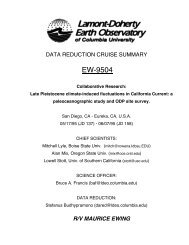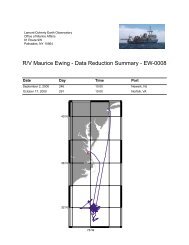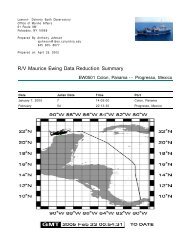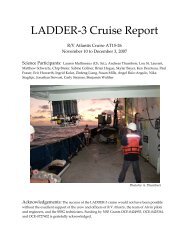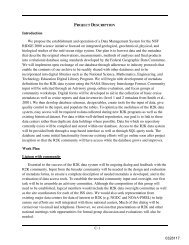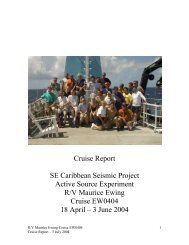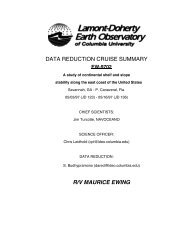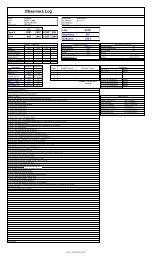variations meant that the first half of the ice was processed at about -15 o C, with some sections a few degreeswarmer. The latter half was typically at about -18 o C. Unfortunately, temperature variations were not notedduring photography.Ship vibration also hampered photography. Vibration was minimized by mounting the light table and camerastand on foam and holding the lens steady. A camera stand that dampened vibrations in the light table,camera, and lens would be helpful. The light table provided by Raytheon was old, dim, and brightnessvaried, particularly when cold.The digital camera for the microscope was old, slow, and rather finicky. It was difficult to focus. A lensmount for a digital SLR camera would be useful.5.4 Ice Mass Balance Buoy and Drifter DeploymentsInstrumentation available for deployment on the ice included four GPS drifers (PI Ackley), one CRREL icemass balance buoy (IMB, PI Ackley), and 3 mini-IMBs provided by the Scottish Association for MarineScience in collaboration with BAS.The four GPS drifters were initially intended for IPY SIMBA project (NBP0709). However, deck tests at thebeginning of that cruise revealed transmission problems presumably due to a cold-temperature sensitivity.Those units were returned to the manufacturer (Trident Sensors) for testing and possible replacement orrefurbishment. Four of those repaired/replaced units were made available for deployment on <strong>NBP09</strong><strong>01</strong>.Unfortunately however our deck tests revealed that 2 of the 4 drifters continued to have chronic transmissionproblems, while the other 2 appeared to reliably transmit on the helo deck even during a cold temperaturesnap where temperatures decreased to -19 to -20 degC. We therefore decided to deploy the 2 operationaldrifters, only to discover that 1 of the 2 also succumbed to transmission problems. We therefore weresuccessful in deploying only 1 working ice drifter. The 2 chronic drifters will be returned once again to themanufacturer for further testing.A CRREL IMB (lead PI Ackley) was deployed on the fast ice in front of the Crosson Ice Shelf, alongsidean WHOI ice-tethered profiler (ITP). The CRREL IMB consists of a 4.5 meter thermistor string (sectionedinto 1.5 meter lengths), with thermistors spaced 10 cm apart for a total of 45. Additional sensors aremounted on two PVC masts, one extending mostly underwater, supporting an upward looking sounder,mounted at about 1.5 meters below the bottom ice surface, for measuring changes in distance to bottom icesurface and a SeaBird SBE39 for measuring temperature, conductivity and pressure. The other PVC mastsupported a downward looking sounder, mounted at about 2 meters above the snow surface, for measuringchanges in distance to top snow surface. The two sounders combined yield estimates of ice mass balancechanges. The surface mast also supports an air temperature probe housed inside a gill plate. All mastsand thermistor strings are white to decrease heat absorption during sunlit days. Each sensor is hookedto a data logger enclosed in a protective white box, which also houses a barometric pressure sensor, theGPS antennae/receiver and Argos transmitter. To date, the CRREL IMB is reliably transmitting all data,though there are indications that the surface air temperature probe is not functioning properly. Fortuantely,the thermistor change extends approximate 1.35 meters above the snow surface, thus providing additionalsurface air temperature readings.The deployment site for the CRREL IMB was on fast ice north of Crosson Ice Shelf at about 3 miles south ofthe fast ice edge and in the near vicinity (within 15 meters) of the WHOI ITP. The deployment site consistedof fairly level ice, averaging at about 50 cm thickness, located southward of an area that was moderatelyridged. Given the 50 cm ice thickness, we decided to overlap the 3rd thermistor section with the other twosections that were in series. This allows 5 cm temperature resolution through the ice-snow-air layers (i.e.,from -50 cm to +80 cm relative to the ice surface).In addition to the CRREL IMB, two SAMS IMBs also were deployed. The SAMS IMBS are designed asa low-cost, easily deployable alternative to a full IMB, with the future potential for deployment of a large<strong>NBP09</strong>-<strong>01</strong> <strong>Cruise</strong> <strong>Report</strong> (p. 40 of 83) Revised February 27, 2009
enough number to be able to regionally charcterize ice growth and melt processes. The design consistsof a single wire of addressable digital temperature sensors with 1/16 of a degree resolution. Each stringconsists of 144 sensors with a 4 cm spacing mounted on a thin flexible PCB that was weatherproofed inheatshrink. Each has a surface mounted resistor that heats the sensor when a voltage is applied, allowingthe thermal response of the sensor to be monitored. This ”hot-wire anemometer” mode will in principle allowdiscrimination of the medium that the sensor is in (i.e. snow, ice, air or water) and hence determination ofsnow and ice thickness without the need for acoustic sounders. A particularly advantageous feature of thissystem is the potential to continuously monitor surface processes such as flooding, snow ice formation, andsnow melt. These processes are a particular focus of the sea ice program.<strong>Data</strong> is recorded using a Persistor CF2 logger and transmitted via Iridium modem. To reduce power consumptionand data transmission costs, temperatures are recorded 4 X daily, and a heating cycle is appliedonce per day. Power is supplied by 80 alkaline D-cell batteries. All components other than the sensor chainare enclosed in a 1550 Pelicase (20 cm x 35 cm x 50 cm).This is the first deployment of these systems in the Antarctic. Modifications from the design used in theArctic include a longer chain to accommodate thick ice and snow and finer sensor spacing to resolve surfaceprocesses.To deploy the IMBs, 2 meters of the sensor chain were cable tied to a 2” diameter ABS pipe to supportthe sensors in the snow and air. This was fixed in the field via a threaded joint to a second pipe that wassecured in a 2” auger hole in the ice. The remaining sensors were run along the ice surface to a hole 40 cmaway and dropped through a drill hole through the ice.Two systems were deployed. A third failed during testing on the helo-deck due to failures in both the sensordriver module and the Persistor logger. The cause of the first failure is unclear, but it is probable that ashort damaged the logger. The first system was deployed at ice station 11 on the Northwest side of theThwaites iceberg tongue. This site was chosen as it was well protected by icebergs and fast ice to the east sohad a fair chance of surviving into the winter. High Resolution ASAR data was provided by BAS under theauspices of the European Polarview project was particularly useful in locating the site and finding a routethrough the iceberg tongue. The IMB was deployed in 2.7 m of sea ice about 1/2 mile from the fast ice edge.At this site, the snow was removed in blocks prior to drilling and then replaced around the snow mast. Thisprevented wetting of the snow, but it is likely that there were air gaps between sensors and replaced snowso that detection of snow in the heating cycle is difficult. The second IMB was deployed at ice station 13 ona roughly 500 m floe in the middle of the pack ice band. The ice was 2.0 m at this site. Rather than clearthe snow, holes were carefully drilled through both the snow and ice. Crushed snow was packed in the gapsaround the sensors to ensure good contact. Both sites were flooded. Deployment of each station took about2 hours.Initial analysis of the data show that the different layers can be resolved, but the thermal response of snowand air are only slightly different. This may be because the response is detected using the temperature riseafter a one minute heating cycle. This may not be sufficient time for the heat to flow through the heatshrink on the sensor chain and deeply into the snow. It may be better to transmit temperature informationat several points during a cooling cycle, similar to what is done with needle probe measurements of thermalconductivity. Further testing of alternative potting methods to reduce thermal mass of the chain would beworthwhile.5.5 Remote Sensing SupportHigh-resolution satellite data has proved indispensible on previous cruises to support navigation through iceand to find suitable ice floes for sampling and instrumentation deployment. Useful satellite data availableon <strong>NBP09</strong><strong>01</strong> consisted of near-real time acquisition of visible OLS (0.55 km resolution) and SSM/I passivemicrowave (12-25 km resolution), and visible band AVHRR (1.1 km resolution) using the Terrascan system.<strong>NBP09</strong>-<strong>01</strong> <strong>Cruise</strong> <strong>Report</strong> (p. 41 of 83) Revised February 27, 2009
- Page 3 and 4: List of Figures1 Regional map of CT
- Page 5 and 6: Universities and to Raytheon Polar
- Page 8 and 9: 1, 7, 104, and 159. At least one ad
- Page 10 and 11: and dissolved oxygen decreasing wit
- Page 12: Primary-Secondary O2 sensor differe
- Page 15 and 16: Run Test 1 2 3 4 5 6 7 8 9 10 11Stb
- Page 17 and 18: In order to estimate the accuracy o
- Page 19 and 20: ice-ocean boundary layer. To do thi
- Page 21 and 22: Figure 17: Using small boat for rec
- Page 23 and 24: Figure 19: Planned mission profiles
- Page 25 and 26: was under way (Figure 17). This met
- Page 27 and 28: # Starttime, pos,duration, km427428
- Page 29 and 30: S. Jacobs O-274-N Mooring Schematic
- Page 31 and 32: at the helm.The high iceberg produc
- Page 33 and 34: Seasonal sea ice changes in the Amu
- Page 35 and 36: in the Amundsen Sea - (1) the confi
- Page 37 and 38: An automated camera system provided
- Page 39: presence of ice layers and wicked b
- Page 43 and 44: 6 Seafloor MappingFrank Nitsche, Ka
- Page 45 and 46: Due to the location of the transduc
- Page 47 and 48: Figure 29: Water column thickness (
- Page 49 and 50: Figure 31: A south-to-north cross s
- Page 51 and 52: phytoplankton from the upper 200m w
- Page 53 and 54: uptake (K m ) as well as the maximu
- Page 55 and 56: Elmer UV/VIS Lambda 18 spectrophoto
- Page 57 and 58: Figure 37: Section plot of dissolve
- Page 59 and 60: ligand ’TAC’ (2-(2-Thiazolylazo
- Page 61 and 62: Both GA and PA, at times, resulted
- Page 63 and 64: 9 Other Sampling and Profiling9.1 O
- Page 65 and 66: Figure 42: XBTs gridded as if they
- Page 67 and 68: on them. A single hollow column is
- Page 69 and 70: in ways that are accessible to a wi
- Page 71 and 72: AppendicesACruise ParticipantsPerso
- Page 73 and 74: BCTD Station TableNo. Date Time Lat
- Page 75 and 76: continued from previous pageNo. Dat
- Page 77 and 78: CPre-cruise Project PlansC.1 Amunds
- Page 79 and 80: Figure 48: Missions, three each, pe
- Page 81 and 82: C.4 Collaborative Research: Samplin



